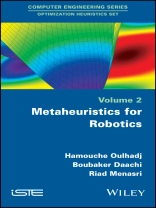This book is dedicated to the application of metaheuristic optimization in trajectory generation and control issues in robotics. In this area, as in other fields of application, the algorithmic tools addressed do not require a comprehensive list of eligible solutions to effectively solve an optimization problem. This book investigates how, by reformulating the problems to be solved, it is possible to obtain results by means of metaheuristics.
Through concrete examples and case studies particularly related to robotics this book outlines the essentials of what is needed to reformulate control laws into concrete optimization data.
The resolution approaches implemented as well as the results obtained are described in detail, in order to give, as much as possible, an idea of metaheuristics and their performance within the context of their application to robotics.
Зміст
Preface ix
Introduction xiii
Chapter 1. Optimization: Theoretical Foundations and Methods 1
1.1. The formalization of an optimization problem 1
1.2. Constrained optimization methods 5
1.2.1. The method of Lagrange multipliers 9
1.2.2. Method of the quadratic penalization 11
1.2.3. Methods of interior penalties 12
1.2.4. Methods of exterior penalties 13
1.2.5. Augmented Lagrangian method 14
1.3. Classification of optimization methods 15
1.3.1. Deterministic methods 16
1.3.2. Stochastic methods 18
1.4. Conclusion 21
1.5. Bibliography 22
Chapter 2. Metaheuristics for Robotics 27
2.1. Introduction 27
2.2. Metaheuristics for trajectory planning problems 28
2.2.1. Path planning 29
2.2.2. Trajectory generation 43
2.3. Metaheuristics for automatic control problems 45
2.4. Conclusion 50
2.5. Bibliography 50
Chapter 3. Metaheuristics for Constrained and Unconstrained Trajectory Planning 53
3.1. Introduction 53
3.2. Obstacle avoidance 54
3.3. Bilevel optimization problem 58
3.4. Formulation of the trajectory planning problem 59
3.4.1. Objective functions 60
3.4.2. Constraints 62
3.5. Resolution with a bigenetic algorithm 63
3.6. Simulation with the model of the Neuromate robot 66
3.6.1. Geometric model of the Neuromate robot 67
3.6.2. Kinematic model of the Neuromate robot 71
3.6.3. Simulation results 72
3.7. Conclusion 83
3.8. Bibliography 83
Chapter 4. Metaheuristics for Trajectory Generation by Polynomial Interpolation 87
4.1. Introduction 87
4.2. Description of the problem addressed 88
4.3. Formalization 91
4.3.1. Criteria 91
4.3.2. Constraints 92
4.4. Resolution 94
4.4.1. Augmented Lagrangian 95
4.4.2. Genetic operators 97
4.4.3. Solution coding 99
4.5. Simulation results 100
4.6. Conclusion 116
4.7. Bibliography 118
Chapter 5. Particle Swarm Optimization for Exoskeleton Control 121
5.1. Introduction 121
5.2. The system and the problem under consideration 123
5.2.1. Representation and model of the system under consideration 123
5.2.2. The problem under consideration 125
5.3. Proposed control algorithm 126
5.3.1. The standard PSO algorithm 126
5.3.2. Proposed control approach 128
5.4. Experimental results 135
5.5. Conclusion 142
5.6. Bibliography 143
Conclusion 147
Index 153
Про автора
Hamouche Oulhadj is an Associate Professor at the University of Paris-Est Créteil, France. He is an Engineer in Electrical Engineering and has a Ph D in Biomedical Engineering. His main research interests are in optimization, pattern recognition and image processing.
Boubaker Daachi is a Full Professor in Computer Science at the University of Paris 8, France. He is an Engineer in Computer Science and has a Ph D in Robotics. His main research interests are in brain computer interfaces, biometrics, neurofeedback and robotics.
Riad Menasri is a Development Engineer at Assystem Technologies, France. Holding a Master’s degree in Advanced Systems and Robotics and a Ph D in Robotics, his main research interests are in optimization and trajectory planning for robotics applications.












